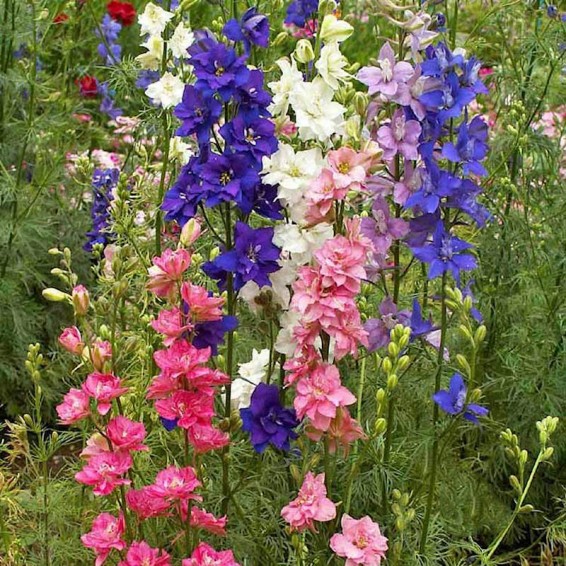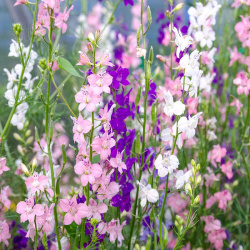Imperial Rocket Larkspur Seed Mix
- HOW TO GROW
- FAST FACTS
- REVIEWS
HOW TO GROW
Sowing: Direct sow 1/8" deep in deeply worked, rich soil. In warm regions the seed can be planted in fall for earlier bloom, while early spring planting is a better time for areas with cold winters. To start the Delphinium Consolida seed indoors, sow 1/8" deep in a flat kept evenly moist and at a temperature of 60 degrees F. This seed germinates rather slowly, but should sprout within 20-30 days. Transplant the seedlings when there is no chance of frost.
Growing: Water the plants regularly, keeping the soil consistently moist. This plant tolerates sandy or clay soils. Avoid overwatering, since excess moisture may cause root rot. The plants should bloom in their first season if started early; otherwise, they will begin blooming in the following summer. After the first crop of blossoms fade the plant may be pruned for new growth and a possible second blooming. These plants will self-seed in good growing conditions. Cut the plant several inches above ground level after the first hard frost. Larkspur attracts hummingbirds, bees, and butterflies.
Harvesting: For fresh flowers, cut long stems of flowers that have just opened; these flowers usually have a vase life of 7-10 days. Delphinium Consolidas also make excellent dried flowers. For this purpose, choose flowers that have fully opened and bundle them, hanging them upside down in a dark, warm place until dried. Handle these plants with care, since the imperial rocket larkspur seeds and leaves contain poison.
Seed Saving: After the flowers fade, this plant will produce papery light brown seed pods that open at the top when ripe. Mature seed will be a dark brown color. Remove entire stalks of ripe seed pods and spread them out to dry. Alternatively, the plants can be shaken over a container to remove the seed from the open pods. Store the cleaned Delphinium Consolida seed in a cool, dry place.
FAST FACTS
Latin Name: Delphinium consolida
Species Origin: Southern Europe
Type: Garden Flowers
Life Cycle: Annual
USDA Zones: 1, 2, 3, 4, 5, 6, 7, 8, 9, 10, 11, 12
US Regions: California, Mountain, Arid/Desert, Plains/Texas, Midwest, Northern, Northeast, Southeast
Seeds per Ounce: 8,900
Stratification: No Stratification
Germination Ease: No Stratification
Sunlight: Full Sun, Part Sun
Height: 24 Inches
Color: Mixed, White, Pink, Blue, Purple
Bloom Season: Blooms Early Summer, Blooms Late Summer
Uses: Hummingbirds, Cut Flowers
Imperial Rocket Larkspur
I cannot wait to sow these Imperial Rocket Larkspur, I have grown Larkspur before,but not this variety, these will be the perfect height,the taller varieties ALWAYS fall over,theses will not,these are the most beautiful,and colorful variety I have ever seen. JUST BEAUTIFUL !!! ThankYou Lee Howard DeCamp
Larkspur Rocket Imperial
5 Stars
The packaging that you rave about....didn't work.
When I received the larkspur, the seeds fell out all over the place. $24. worth...it was a collosal mess. the packaging was somehow not sealed at the bottom...so one has to question the freshness of the product.
Very Happy With Everwilde
I only discovered Everwilde Seeds last year because my usual source was sold out of everything and I couldn't be happier! I've placed a few orders and so far not only are the seeds fresh and prices more than reasonable, but they also go as far as to insure their seeds are packaged in great heavy duty resealable envelopes. You will never have to worry about seeds falling out or having to fold under a torn paper packet. Also, so my germination rates have been very good.
Favorite!
These are among my favorite flowers. I don't often have luck with them because they prefer cooler weather and sometimes spring in Des Moines turns hot quickly. Here's hoping!
generous amount of seeds!
I will sow seeds in November so can't report on germination, but this is a very generous amount and your packaging is very nice. I am impressed.
Fresh seed of carefree self-seeding annual
Generous portion of seed of this festive plant of the roadside and prairie garden.
My garden
I adore Everwilde seeds!
DESCRIPTION
HOW TO GROW
Sowing: Direct sow 1/8" deep in deeply worked, rich soil. In warm regions the seed can be planted in fall for earlier bloom, while early spring planting is a better time for areas with cold winters. To start the Delphinium Consolida seed indoors, sow 1/8" deep in a flat kept evenly moist and at a temperature of 60 degrees F. This seed germinates rather slowly, but should sprout within 20-30 days. Transplant the seedlings when there is no chance of frost.
Growing: Water the plants regularly, keeping the soil consistently moist. This plant tolerates sandy or clay soils. Avoid overwatering, since excess moisture may cause root rot. The plants should bloom in their first season if started early; otherwise, they will begin blooming in the following summer. After the first crop of blossoms fade the plant may be pruned for new growth and a possible second blooming. These plants will self-seed in good growing conditions. Cut the plant several inches above ground level after the first hard frost. Larkspur attracts hummingbirds, bees, and butterflies.
Harvesting: For fresh flowers, cut long stems of flowers that have just opened; these flowers usually have a vase life of 7-10 days. Delphinium Consolidas also make excellent dried flowers. For this purpose, choose flowers that have fully opened and bundle them, hanging them upside down in a dark, warm place until dried. Handle these plants with care, since the imperial rocket larkspur seeds and leaves contain poison.
Seed Saving: After the flowers fade, this plant will produce papery light brown seed pods that open at the top when ripe. Mature seed will be a dark brown color. Remove entire stalks of ripe seed pods and spread them out to dry. Alternatively, the plants can be shaken over a container to remove the seed from the open pods. Store the cleaned Delphinium Consolida seed in a cool, dry place.
FAST FACTS
Latin Name: Delphinium consolida
Species Origin: Southern Europe
Type: Garden Flowers
Life Cycle: Annual
USDA Zones: 1, 2, 3, 4, 5, 6, 7, 8, 9, 10, 11, 12
US Regions: California, Mountain, Arid/Desert, Plains/Texas, Midwest, Northern, Northeast, Southeast
Seeds per Ounce: 8,900
Stratification: No Stratification
Germination Ease: No Stratification
Sunlight: Full Sun, Part Sun
Height: 24 Inches
Color: Mixed, White, Pink, Blue, Purple
Bloom Season: Blooms Early Summer, Blooms Late Summer
Uses: Hummingbirds, Cut Flowers
Reviews
Review
Imperial Rocket Larkspur
I cannot wait to sow these Imperial Rocket Larkspur, I have grown Larkspur before,but not this variety, these will be the perfect height,the taller varieties ALWAYS fall over,theses will not,these are the most beautiful,and colorful variety I have ever seen. JUST BEAUTIFUL !!! ThankYou Lee Howard DeCamp
Review
Larkspur Rocket Imperial
5 Stars
Review
The packaging that you rave about....didn't work.
When I received the larkspur, the seeds fell out all over the place. $24. worth...it was a collosal mess. the packaging was somehow not sealed at the bottom...so one has to question the freshness of the product.
Review
Very Happy With Everwilde
I only discovered Everwilde Seeds last year because my usual source was sold out of everything and I couldn't be happier! I've placed a few orders and so far not only are the seeds fresh and prices more than reasonable, but they also go as far as to insure their seeds are packaged in great heavy duty resealable envelopes. You will never have to worry about seeds falling out or having to fold under a torn paper packet. Also, so my germination rates have been very good.
Review
Favorite!
These are among my favorite flowers. I don't often have luck with them because they prefer cooler weather and sometimes spring in Des Moines turns hot quickly. Here's hoping!
Review
generous amount of seeds!
I will sow seeds in November so can't report on germination, but this is a very generous amount and your packaging is very nice. I am impressed.
Review
Fresh seed of carefree self-seeding annual
Generous portion of seed of this festive plant of the roadside and prairie garden.
Review
My garden
I adore Everwilde seeds!










